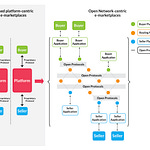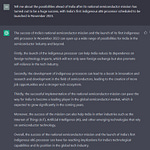Antariksh Matters #1: Telangana’s SpaceTech Framework
— Aditya Pareek
In its latest policy document, “SpaceTech Framework”, the Government of Telangana acknowledges the central role of private enterprise in the rapidly growing global space economy. The twelve page long document lays down a framework to nurture the state’s own private space tech sector. There is a notable focus on enabling entrepreneurship in both upstream and downstream applications as well as removing many bottlenecks and regulatory hurdles.
The policy seeks to attract global investment and setup partnerships with international entities to boost space related manufacturing in the state. Telangana also wishes to become a globally preferred destination for setting up new space related ventures and as a sandbox or testbed for SpaceTech applications like remote sensing. The framework laid out to achieve these objectives, has four key policy pillars - enabling access to infrastructure, business facilitation & collaboration, skill development & training, promoting research and innovation. The policy also pays due regard to involving varied stakeholders and deriving socio-economic benefits across areas & sectors - such as agriculture, insurance, urban development & planning, disaster management, digital connectivity and ecological protection etc.
Hyderabad, Telangana’s capital, already has many advantages, including being the base of institutions and high-tech facilities like ISRO’s National Remote Sensing Centre (NRSC) and the International Advanced Research Centre for Powder Metallurgy and New Materials (ARCI). Telangana has also contributed a significant share to ISRO’s national space efforts, most recently with supplying almost 30% of parts used in India’s Mars Orbiter Mission(MOM).
Building on this momentum, the Government of Telangana has identified a “space market value chain”, which stretches from identifying end users to the upstream manufacturing sub sectors. To support this value chain, Telangana aims to encourage public private partnerships and the sharing of expensive high-tech testing and Research & Development(R&D) facilities by both government institutions and startups who can’t afford to set up their own. Some specifically identified R&D and testing facilities apart from the above mentioned ISRO-NRSC and ARCI include - Electronics Corporation of India Limited(ECIL) and the regional complexes of Defence Research and Development Organisation (DRDO). By identifying some high-impact use cases, the Government of Telangana also aims to prioritise solving problems which are pressing and have a direct impact on the state, its industry, populous and the nation at large.
The government of Telangana also plans to provide competitively priced land in strategic locations inside the state for SpaceTech companies to set up their facilities - including commercial ground stations for satellite constellations. Telangana also has plans for an INR 1,300 crore fund meant for supporting startups under its Information and Communicational Tech.(ICT) policy, the policy explicitly says that space tech startups would also be eligible for support from this fund.
As a way to harmonise its other high-tech initiatives such as Telangana’s AI Mission (T-AIM) and Open Data Platform, the policy also advocates for the State Government, Union Government and space tech companies involved in geospatial applications like earth observation, to synergise all efforts. Furthering the cause for synergising the state’s development goals and national space endeavours, Telangana hopes to facilitate partnerships between its own space tech industry and national Public Sector Undertakings (PSU), Union Government agencies, and foreign companies.
The Government of Telangana also plans to support individuals and startups in the space tech sector with Intellectual Property (IP) development and preservation by providing advisory services in filing patents and ensuring legal compliance both domestically and internationally. The focus is also on the insurance, banking and financial services sectors. The policy highlights the need for a better understanding in analysing the risk associated with building and operating big ticket items like privately owned and built space launch vehicles and satellites.

Matsyanyaaya: How Does the India-EU Trade and Technology Council Work?
— Arjun Gargeyas
I had written long back in this newsletter about the proposed US-EU Trade and Technology Council and how it actually reveals the fissures that divide them with respect to technology cooperation and regulation.
Fast forward to the present and we have the president of the European Union (EU), Ursula von der Leyen visiting India during the ongoing Russia-Ukraine war. An interesting aspect of the visit was the harmony between both India and the EU on most matters with the exception of the Ukraine war. But the highlight of the visit was the establishment of the India-EU Trade and Technology Council modeled after the US-EU agreement.
This is the first time India has signed any such agreement with any of its partners. It will allow the two partners to address challenges in trade, trusted technology, and security, deepening cooperation in these fields. The primary objective behind the agreement is to ensure both sides can work in collaboratively in fields such as 5G, artificial intelligence, climate modelling, and health-related technology.
While the talks behind the proposed India-EU Free Trade Agreement (FTA) have gone on for over a decade, this agreement comes as a positive step towards building a partnership between India and its third-largest trading partner. It should also be noted that the EU has extended this kind of agreement in technology-related domains only to the US and India thus far.
Reports say that the Trade and Technology Council will provide the political steer and the necessary structure to operationalise political decisions, coordinate technical work, and report to the political level to ensure implementation and follow-up in areas that are important for the sustainable progress of European and Indian economies.
The current Technology Council between the US and EU has introduced the concepts of different working groups and departments in charge of translating the political decisions into actual deliverables. These working groups range from investment screening, climate technologies, and supply chain resiliency among others. A similar working setup is likely to be adopted in the India-EU agreement depending on the comparative advantages that both partners have to offer in the technology markets.
But one of the other questions that still needs to be answered is the effectiveness of the agreement. This depends on the extent to which the EU is amenable to sharing critical technology with India. There are some strategic areas of technology that domain leaders like the EU might not be willing to pass on to India. The question of how they can navigate this kind of impasse can determine the extent to which the agreement can flourish.
Similar to the US-EU Trade and Tech Council agreement, this agreement will have the clouds of technology regulation hanging over it. Both partners view the process of regulating technology from a different perspective. The differences in the EU’s General Data Protection Regulation (GDPR) and India’s proposed Personal Data Protection Bill highlights the change in approach taken by both parties. Finding a common ground to important questions like these is imperative if the signed agreement can actually result in deliverables.
It is indeed a welcome surprise that the India-EU Trade and Technology Council has been initiated considering the indecisiveness that existed in finalising the FTA. This offers a great opportunity for both countries to tap into each other’s strengths and overcome their weaknesses in the technology sector through consistent cross-border trade and flow of labour, capital and IP.
Antariksh Matters #2: ISRO’s Annual Report Looks at Both Hits and Misses
— Pranav R. Satyanath
The Indian Space Research Organisation (ISRO) released its annual report last month, which highlights the organisation’s major activities in the past year and plans for future missions and satellite launches. Main highlights of the report are as follows:
ISRO’s accomplishments in developing indigenous navigation capability:
The Navigation Indian Constellation (NavIC) consists of a constellation of eight satellites which provide standard positioning services for civilian use and restricted services for the government and military services. According the the report, ISRO has worked towards enabling NavIC services on mobile devices, and integrated the Second Generation Distress Alert Transmission (SG-DAT) to provide services such as the broadcasting distress alerts in remote locations.
Advancements in indigenous launch capabilities
According the ISRO’s annual report, there have been two major improvements in the development of indigenous launch capabilities, First, the development of the three-stage solid-fueled Small Satellite Launch Vehicle (SSLV) which can launch small satellites weighing upto 500 kg into Low Earth Orbit (LEO). Second, the development of the Reusable Launch Vehicle (RLV) is currently under initial ground-testing stage using a demonstration vehicle.
Development of the Gaganyaan Human Space Flight mission
The 2021-2022 annual report provides a greater level of detail into the Gaganyaan Programme in comparison to last year’s year’s report. Information regarding the design of the orbital module, crew module and the parameters of testing along with the results of the initial testing of the service module propulsion systems have been provided. Although an initial date for the launch is yet to be confirmed, it is likely that the first unmanned launch will occur some time in 2023.
Other highlights include ISRO’s steps in building space situational awareness (SSA) capabilities. The report highlights the use of the radars and electro-optical telescope for tracking objects up to 10cam or higher in LEO, and tracking objects 40cm or higher in Geosynchronous Earth Orbit (GEO). In March 2022, ISRO released its first report on Space Situational Assessment, which goes into greater detail regarding India’s debris mitigation activities. During the recent US-India 2+2 Ministerial Dialogue, India and the US signed a Memorandum of Understanding on SSA cooperation. The US currently operates the world’s largest SSA network, called the United States Space Surveillance Network and provides open-access data of all indexed objects in space.
Although ISRO’s annual report highlights several developments in the past year, it is also a reminder of some of the key shortcomings that India faces in the space sector. The most prominent of which is the lag in the number of launches. India conducted just one launch of the PSLV between 2021 and 2022. Further, ISRO also faced a major setback when the GSLV F10 failed to launch due to low pressure in the cryogenic upper stage of the rocket. At a time when the world has witnessed a record number of space launches, India’s lack of sustainable launch capability is a reminder that India must build capacity — in both state-owned and private space industry.
Antariksh Matters #3: Developing an Indian Augmentation for GPS
— Aditya Ramanathan
Last week, ISRO and Airports Authority of India (AAI) made significant progress on the path to operationalizing the homegrown satellite-based augmentation system (SBAS) called GAGAN.
On 28 April, an IndiGO ATR 72 aircraft landed at Kishangarh airport near Ajmer, Rajasthan, using GAGAN-based Localiser Performance with Vertical Guidance or LPV.
LPVs are similar in concept to the more conventional Instrument Landing System (ILS) used in larger airports, which enables aircraft to land in less-than-ideal conditions. The key difference is that while ILS requires the airport to have the requisite antennae and transmitters, LPV uses satellite signals from an SBAS. In effect, LPVs allow aircraft to land at smaller airports that lack ILS, even when there’s poor visibility or bad weather.
The SBAS Promise
GAGAN is a relatively new entrant in the SBAS club. The American Wide Area Augmentation System (WAAS), which covers North America, was a pioneer. Other systems include the European Union’s EGNOS and Japan’s MSAS. China is developing an SBAS of its own based on its BeiDou constellation of navigation satellites. South Korea, Australia, Russia are among other states either operating or developing their own SBAS. The primary use of SBAS is for aviation, and any operational SBAS must be reliable and accurate enough for such “safety of life” uses. Besides aviation, SBASs can also be used by ships maneuvering in narrow canals or by public road and traffic management services.
GAGAN is short for GPS Aided GEO Augmented Navigation. Like all other augmentation systems, it uses a combination of ground stations and satellite-based transmitters. On Earth, 15 reference stations receive GPS signals, which are then collated at two master control centres, which correct them for ionospheric distortion, orbit errors, and timing errors on the atomic clocks that navigation satellites use. Three geostationary satellites (GSAT-8, GSAT-10 and GSAT-15) then broadcast the corrected signal back to Earth.
Adopting GAGAN
India’s aviation regulator, the Directorate General of Civil Aviation (DGCA) has already made it compulsory for all aircraft registered in the country after July 2021 to have GAGAN receivers onboard. However, for adoption to really take off, SBAS around the world will have to ensure seamless interoperability. India is part of an Interoperability Working Group with representatives from GAGAN, WAAS, EGNOS, and MSAS. But the task of interoperability is only likely to get more complicated in the future, as SBASs begin to rely on multiple satellite navigation constellations and transmit in multiple frequencies. This newsletter will keenly track these developments.
Our Reading Menu
[Opinion] How should India respond to the US's unilateral ASAT test ban? by Pranav R. Satyanath who is also a contributor to this newsletter
[Article] How military technology reaches Russia in breach of U.S. export controls by David Gauthier-Villars, Steve Stecklow and John Shiffman
[Article] Data as a weapon: Psychological Operations in the age of irregular information threats by Jon Reisher, Charity Jacobs and John Beasley
[Blog] On space barons and global poverty by Harun Onder







